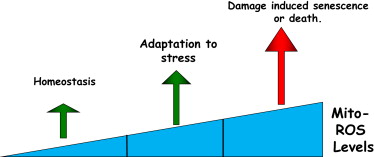
Mitochondria are the batteries of your cells.
Mitochondria, ATP, what does it all mean?
Mitochondria…so you want to find out what they are, huh? Well you’ll find out soon enough.
But first, we are going to talk about ATP.
As you may or may not know, ATP is the currency of life.
It is THE energy molecule responsible for fueling life as we know it.
Without ATP, life is not possible.
In case you haven’t got the picture yet…

Thanks Ron.
So where does this omnipotent energy source come from? Mitochondria.
Mitochondria are the powerhouses located in every cell in the body. The number of mitochondria in a single cell can range from 0 to over 2,000(S). You can imagine the mitochondria to be tiny batteries that provide energy(ATP) for the cells, and ultimately the organism, in which they reside.
Where did they come from?
The Endosymbiotic Theory suggests that mitochondria were once their own organism, likely a bacteria, that was then consumed by a larger organism. Somehow the mitochondria survived digestion and became a part of the larger organism.
- Symbiosis is when two organisms live and work together and help each other equally. It is a relationship that benefits both partners. Much like the one I have with my wife, right honey?

- Endosymbiosis is the same thing, except that one organism lives inside of the other – like the mitochondria living inside of the cell.
So the mitochondria benefited because they gained protection and nutrients, while the larger organism benefits because of the specialized ATP production. That’s the gist of it anyways, and it’s pretty awesome.
It is awesome because in the grand scheme of things, everything boils down to SURVIVAL. Anything that can increase an organism’s chances of survival is favorable.
Survival of the fittest.
Survival of the strongest.
Survival of the smartest.
Humans are social creatures. To help our species live, we create communities. Whether it is the familial, agricultural, or technological community, we depend on the existence of these to increase our survival. Few of us are truly self sufficient, but this isn’t necessarily a bad thing…
Look at it this way: If you raise your own livestock and grow your own crops, then you are investing a lot of time into this. This is time that you can’t take back.
However, if you go to the grocery store to buy your food, you are saving a lot of time. This saved time can devoted towards exercising, researching, learning a new hobby, a business venture, or anything.
This is sort of how the mitochondria benefit the host. They produce energy so your cells can spend its time performing other functions.

“You hear that baby? You have MY mitochondria!”
Now, back to mitochondria.
Mitochondria are unique because they have their own mitochondrial DNA and because they are only inherited from your mother(S).
So you can thank your mom – and your mom’s mom, and your mom’s mom’s mom, and her mom’s mom’s mom’s mom – for your sluggish mitochondria 😛 .
But don’t be fooled: this doesn’t mean you are “stuck” with bad mitochondria.
Many physical and dietary stimuli are capable of positively influencing mitochondria. I will delve into these methods in Mitochondrial Biogenisis – Fix your ATP, Fix your Life.
What are Mitochondria Responsible for?
- Energy Production – “Their primary role is to produce 90% of a cell’s energy in the form of ATP through a process called oxidative phosphorylation(S).”
- Cellular Signalling – Mitochondria mainly send signals to the rest of the body through mitochondrial Reactive Oxygen Species. These mROS are a natural by-product of ATP creation, but they can also accumulate from cellular insults.
Too much mROS is bad and leads to cellular damage and cell death. However, too little mROS is also bad because it keeps your body from correctly adapting to stimuli.
Much like anything else in life, you want a balance.
Proper levels of mROS are vital for:
- Adaptation to hypoxia(countering low oxygen)
- Regulation of autophagy(cellular recycling)
- Regulation of immunity(pathogen removal)
- Regulation of differentiation(stem cells)
- Regulation of longevity(length of life)(S).
- Apoptosis Regulation – Apoptosis is programmed cell death. Mitochondria are involved the release of caspase activators(S). These caspases are aptly named the “executioner” proteins(S). The main trigger of apoptosis is DNA damage, which makes sense because you don’t want cells with damaged DNA to replicate and form new cells that also contain the damaged code, right(S)?
-It is also shown that a malfunctioning apoptosis pathway leads to uncontrolled tumor growth and also autoimmune diseases(S).
- Steroid Synthesis – In the steroidogenic cells of the adrenal, gonad, placenta and brain, mitochondria convert cholesterol into steroid hormones(S). One of these hormones includes pregnenolone. Pregnenolone is called the “mother” hormone because it can be converted into many other hormones(S). It is also a neurosteroid.
-It should be known that alcohol can entirely stop this process(S).
- Mitochondria are also responsible for regulating the membrane potential, calcium signalling, and regulating cell metabolism(S).
As you can see, the mitochondria are pretty damn important.
So important that many cell biologists support the theory that mitochondrial number and function determines human longevity(S).
This makes sense, because having a small amount of poor functioning mitochondria would mean that your body would have a severely limited amount of energy, ATP, for survival.
An organism with a poor ability to manufacture the vital life energy would surely have a decreased life-span.
How Do Mitochondria Make Energy?
Long story short, they use food and oxygen to produce the ATP molecule.
Click here to see what it looks like.
Understanding the process isn’t as important as knowing that it makes ATP.
We truly owe the mitochondria our life, but there is one problem…
The process of creating ATP also creates Reactive Oxygen Species. As stated earlier, normal amounts of ROS are needed for good health, but when it gets out of hand – problems occur.
You see, the mitochondria have few mechanisms to protect them from damage. This makes them dependent on the cell they resides in to quell these free radicals.
However…
If you are consuming a nutrient-poor diet that’s filled with processed junk foods, then you probably don’t have enough antioxidants to help out the poor mitochondria.
When ROS are left unchecked, they can break proteins, and damage DNA in the cells. This progressive increase in mitochondrial damage is strongly associated with aging. This is also known as the “Free Radical Theory of Aging(S,S).”
It is the same reason that many believe mitochondrial dysfunction to be behind major health issues.
These health issues include, but are not limited to: autoimmune diseases, Parkinson’s disease (PD), Alzheimer’s disease (AD), autism, cancer, Huntington’s disease, schizophrenia, bipolar disease, dementia, epilepsy, migraine headaches, strokes, neuropathic pain, ataxia, transient ischemic attack, cardiomyopathy, coronary artery disease, chronic fatigue syndrome, fibromyalgia, retinitis pigmentosa, diabetes, hepatitis C, and primary biliary cirrhosis to name a few(S)(S)(S)(S)(S)(S)(S).
If you have any kind of health issue, there is a good chance that mitochondria are involved in some way, shape, or form…
What Else Damages Mitochondria?
- Poor Diet – Fried foods, processed foods, sugar, white flour, high fructose corn syrup, etc all cause inflammation – along with nutrient deficiencies. Read my article “Gut Health: Is Your Stomach in Jeopardy?” for more information on the link between diet and inflammation.
It works like this:
Crap food leads to inflammation -> Chronic inflammation leads to oxidative damage -> Oxidative damage leads to reduced antioxidant capacity -> Reduced antioxidant capacity leads to even more damage(S).
It’s a vicious cycle folks, literally.
As Hippocrates said, “LET FOOD BE THY MEDICINE…”
- Chronic Sun Exposure – The UV radiation that the sun emits enables a cascade of events that can lead to DNA damage. UV rays are the same band of light responsible for giving you that nice summer tan. This tanning process is actually a self-defense mechanism that aims to prevent cell damage from occurring.
-However, too much sun can be a bad thing. Over-exposure to UV rays creates Radical Oxygen Species – there it is again – that persist even after you leave the beach.
You know the drill: Too much ROS leads to cell damage, which can lead to mutations and cell death. This is the equation for skin cancer development(S).
-What can you do to avoid this?
Well for one you build up your tolerance to the sun in the same way you ease into a new exercise routine. Start out low, then work your way up.
If you go from no sun exposure all year to staying out on the beach in Cancún for a whole day – you will be one sorry amigo rojo.
-Secondly, In Part II I will show you guys a key antioxidant that is able to mitigate sun exposure…and it fits in quite nicely with enhancing mitochondria 🙂 .
- Over-excitement of NMDA Receptors – What the what? These receptors are like an “on and off” switch for your cells.
-Artificial sweeteners like aspartme and MSG, as well as environmental toxins, infections, allergens, and stress can trigger an overexcited state in the cells.
– This state stimulates the NMDA receptors to flood the cells with too much calcium and causes a cascade of signals that produce free radicals(ROS), damage the mitochondria, and lead to their demise.
- Pollutants, chemicals, cigarettes, and alcohol – These all can cause increased ROS production(The UltraMind Solution – a great book).
- Medications – The list of medications that interfere with proper mitochondria function is quite lengthy. Therefore,
I HIGHLY recommend you open this page: DRUGS WITH MITOCHONDRIAL TOXICITY and use “Ctrl+F” on your keyboard to search for drugs that you might be consuming.
Congratulations!
You made it through the tough part.
Now you can relax.
Go ahead, take a deep breath.
Feeling better now? Good.
That’s what I wanted to hear.
Let’s continue…
Press “Play” to be taken on a journey narrated by yours truly.
As you can see, the odds are stacked against us.
Despite the constant daily assaults each and every single cell fights to survive.
Your cells fight to survive despite the fact that you keep shoveling garbage down your throat and clouding your cells with noxious cigarette fumes.
Your cells fight to survive despite your aptitude for severe sendentarism and total disregard for your current condition.
Your cells fight to survive… Why don’t YOU join them in this fight?
This war is happening right now inside of you.
You need to be fighting every day if you wish to come out on top.
Join your cellular comrades in this brutal war and feel the satisfaction in declaring victory with each passing day.
If you haven’t been fighting in this battle, then there is no better time to start than NOW.
Neglecting to do so goes against the natural order of life, and in case you forgot what that is – it’s SURVIVAL.
If you aren’t fighting, then you are dying.
If you aren’t trying, then your life is winding-
down. The hands on your clock tick and tock-
faster and faster. Until your time is up, and your body turns Casper.
Your body is a tight-knit group of cells that miraculously work together to keep you alive and well.
Why wouldn’t you help them win this fight?
Be a part of your battalion of cells and take care of the only fucking body you will ever have, and BE DAMN PROUD of your accomplishments.
This is a once in a lifetime opportunity.
Don’t stand by and watch your life fade to dust.
Grab life by the horns, before you rust.
But maybe… I’m being too harsh…
Maybe you weren’t aware of the compounding damage that these factors have on your body.
Well,
NOW YOU ARE.
So, any further decisions to neglect these risks…
To neglect your OBLIGATION as a human being…
Means that you are willfully and knowingly killing yourself.
Slowly, but surely you will be greeting death.
Sooner rather than later…
And that’s the cold, hard truth.
Now that you KNOW BETTER, I hope you take the action to DO BETTER.

THE POWER IS YOURS.
The end.
Keep your eyes peeled for Part II.
And as always:
-Matt
Photos By: Sumetho, Cinema Blend, Nenetus, and Marin
Songs: Neal Acree- Nightsong and Thomas Bergersen – Cry


Great article!!!! Very informative, easy to follow. Really opens your eyes to alot of different issues. Can’t wait for next article!!!!
Thank you!
Matt
Excellent work. You have taken a very complicated subject and made it very relevant to the world. Keep it coming !
Thanks William, that means a lot to me!
Would you happen to know if Sucralose(splenda) is also a agonist of the NMDA Receptors?
Stevia tastes pretty crappy.
Cant seem to find the research on this
Ha
I’m not able to find any research either…
Many places claim sucralose antagonizes NMDA receptors like aspartame, but don’t provide their source.
I would err on the side of caution.
Have you tried erythritol or xylitol?